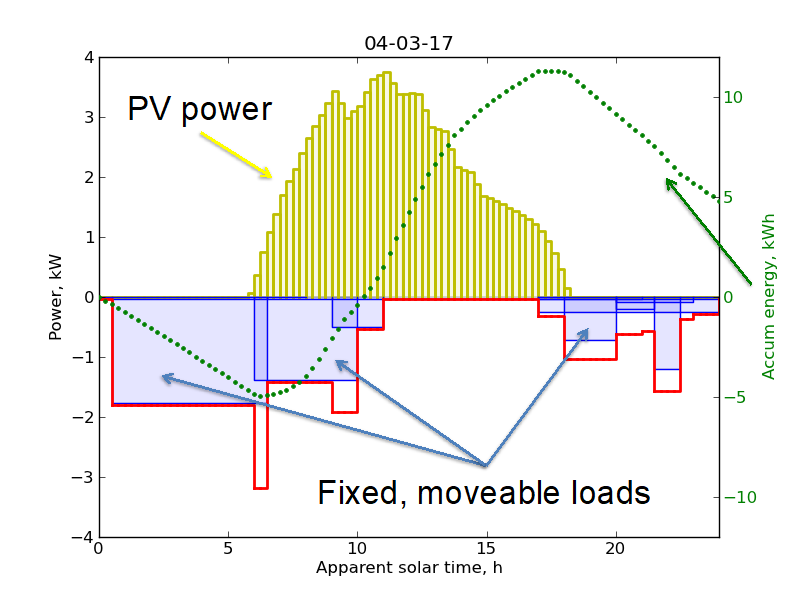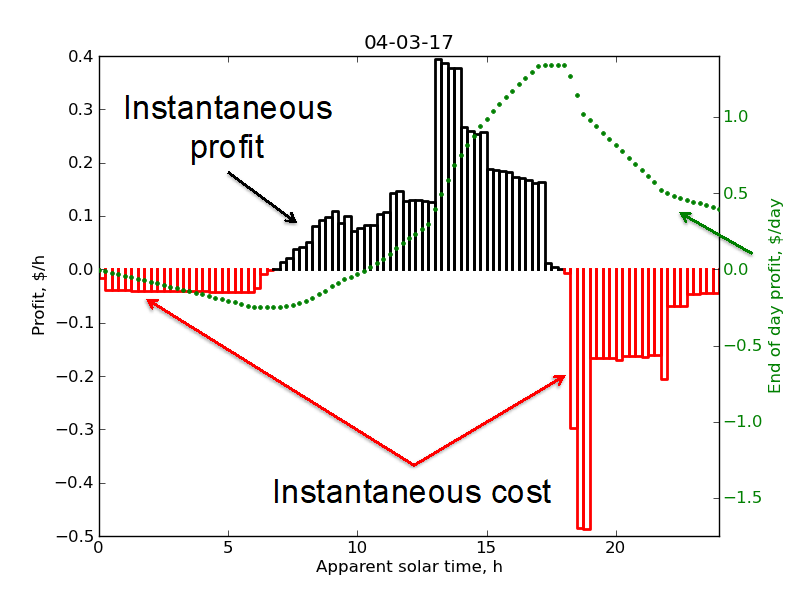Automation
To achieve its degree of adaptability, reACT (and future instances and iterations of its design) must be self-aware. Since January 2016, the reACT Automation Team has been building and testing a physically based simulator of the house electrical and thermal energy, water, and CO2 dynamics that is capable of predicting the house resource inventories and economic performance based on the local weather forecasts.
Among the numerous modeling elements produced by the team is a module that predicts the sun's irradiance as a function of house location and time of year that is combined with cloud-cover forecasts to determine the incident solar irradiance on each external surface of the house, including all windows and PV modules. An equivalent-circuit PV cell model is matched to the PV manufacturer's performance data to determine the power produced by the PV arrays over the course of the day using the predicted irradiance levels. Nominal scheduled electrical loads have been identified and are stored in a machine-readable (XML) format; the loads are read by the simulator and used to compute energy consumption associated with regularly scheduled events. Incident radiation and indoor/outdoor air temperature variations are used to determine heat transfer rates through the house external walls. External wall and window heat transfer, direct radiation through the house windows, and waste heat produced within the house determine HVAC loads, indoor air temperature, and overall net power consumption/production.
What we have produced is a virtual house that can be placed anywhere in the US, as well as most places in the world. Since October last year and shortly after local midnight every day since, a sequence of Python scripts automatically read the weather reports for College Park and the 2017 Solar Decathlon competition site in Denver and predicts the performance of Team Maryland's virtual reACT houses over that day (reactvirtual.eng.umd.edu). Since the onset of this project, we have been accumulating predicted performance data in terms of solar power produced, power consumed by household events, such as charging the car early each morning and making dinner in the evening, and then translating that into the instantaneous profits and costs (see Figure 2 below). The plots illustrate the day's performance - even on the partly cloudy day shown, our virtual house predicts a significant net-positive energy behavior and a tiny virtual profit for the virtual occupants.


Figure 2. A representative prediction for instantaneous power and daily energy production for virtual reACT located in College Park (left); a summary of that day's economic performance (right). One can find today's predicted performance online at reactvirtual.eng.umd.edu.
Based on our model modeling framework's predictive power, we have developed a hierarchical control framework to further optimize the use of water, electrical and thermal energy, and carbon-based resources. The strategy we have developed is based on house automation being controlled by a model-based (the virtual house) supervisory control architecture. We developed this approach to optimizing the house resources based on the objective of avoiding the need to micromanage all house functions. This strategy ensures fault tolerance of our system (the house will continue function in a default mode with the system turned off), that it will be minimally invasive, and it will maximize both potential for upgrades and compatibility with existing and future home automation technologies.
As such, our control objective is to optimize the sequencing of events that consume or produce significant quantities of energy, water, and other resources to maximize both the sustainability and economic goals of the household. Given the scalability of our software design, in the future we will seek to optimize the shared resources of a community of houses, both in terms of controlling common and individual household resources.